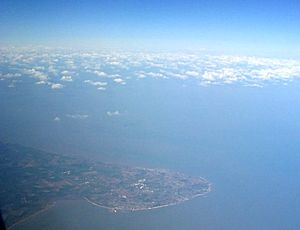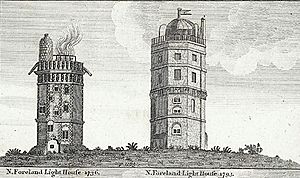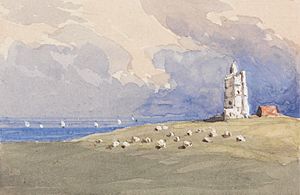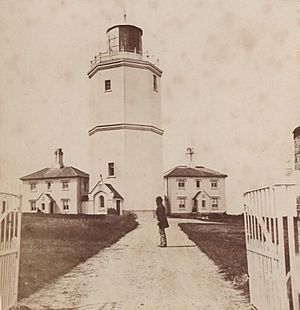North Foreland facts for kids
North Foreland is a chalk cliff on the coast of Kent in southeast England. You can find it in the town of Broadstairs.
It's the easternmost part of Kent's biggest peninsula, the Isle of Thanet. This bold cliff faces the sea and offers great views over the southern North Sea.
Contents
North Foreland Lighthouse
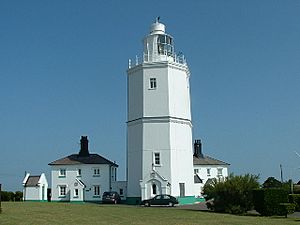 |
|
| North Foreland Lighthouse | |
| Coordinates | 51°22′30″N 1°26′42″E / 51.37490°N 1.44510°E |
|---|---|
| Year first constructed | 1636 (first) |
| Year first lit | 1691 (current) |
| Automated | 1998 |
| Construction | stone tower |
| Tower shape | octagonal tower with balcony and lantern attaches to a 2-storey keeper's house |
| Markings / pattern | white tower and lantern |
| Height | 26 m (85 ft) |
| Focal height | 57 m (187 ft) |
| Original lens | 1st order catadioptric fixed lens |
| Intensity | 60,800 candela |
| Range | 19 nmi (35 km; 22 mi) |
| Characteristic | Fl (5) RW 20s. |
| Admiralty number | A0966 |
| NGA number | 1364 |
| ARLHS number | ENG-087 |
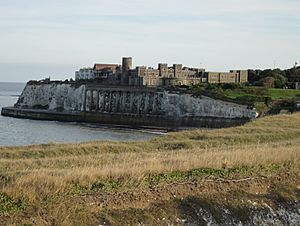
Early Lighthouse History
People probably used some kind of signal fire here even before a proper lighthouse. The first clear record of a lighthouse at North Foreland is from 1636. King Charles I gave Sir John Meldrum permission to keep and rebuild lighthouses on both the North and South Forelands.
Sir John's lighthouse was a wooden house with a large glass lantern on top. It helped guide ships. Sadly, this house burned down in 1683. For a few years after that, they just used a simple beacon with a hoisted light.
Later, a strong, eight-sided tower made of flint was built. On top, there was an open iron grate where a big coal fire burned brightly at night. In 1719, the ownership of the North and South Foreland lights went to the Trustees of Greenwich Hospital.
Changes in the 1700s
Around 1732, the top of the lighthouse was covered with a lantern that had large windows. People used bellows to keep the fire bright all night. This was meant to save coal, but it also protected the fire from rain. However, this new design didn't work well. Many ships got lost because they couldn't see the light. Sailors said they often saw the land before they saw the light, especially in foggy weather. They remembered that when the fire was open to the air, the wind made it blaze brightly and it could be seen from far away.
Because of many complaints, the governors of Greenwich Hospital sent Sir John Thomson to fix the problem. He ordered the lantern to be removed, and the lighthouse went back to its old style. The fire continued to burn all night until daylight.
Towards the end of the 1700s, the lighthouse was changed and repaired a lot. In 1792, under John Yenn, two more stories of brick were added. This made the lighthouse 100 feet tall, including the lantern room at the top. To prevent fires, the lantern room and the walkway around it were covered with copper. Many visitors to Margate liked to visit this walkway for the wide views. At the same time, oil lamps were put in the tower. A new optical system was also added, using lamps and reflectors with special glass lenses.
The Lighthouse in the 1800s
In 1832, Trinity House bought the North and South Foreland lighthouses from Greenwich Hospital. Two years later, the old lenses were taken out. In 1858, a new, bigger lantern was built on top of the lighthouse. It was 14 feet wide and 22 feet tall. Inside, a new oil burner was installed, along with a large, special lens called a first-order Fresnel lens. This lens was made in Paris and first lit on March 26, 1860.
Three months later, a red light section was added. This red light shone north to help ships stay away from Margate Sand at night.
The tower itself was also updated. Two homes for the lighthouse keepers were built next to it. The inside of the tower, which used to have many rooms, was completely emptied. A new circular brick wall was built inside. This wall supported a new stone staircase that went from the ground to the room just below the lantern. Most of the outside windows were blocked up, and the outside of the tower was covered with cement and painted white. All this work was finished in 1866, making the lighthouse look much like it does today.
In 1880, the light started to "occult," meaning it would go dark for five seconds every half minute. The light got even better in 1894 when a new, powerful oil lamp was installed.
The Lighthouse in the 1900s
The lamp continued to be improved in the early 1900s. A new burner was installed in 1904, and another in 1923. Then, in 1930, the light became electric. At the same time, it was given its current light pattern: five flashes every twenty seconds. The old lens from 1860 was still used, so the lamp itself was made to flash. The light came from a tungsten filament lamp, with a backup lamp and an emergency acetylene lamp. Also in 1930, a radio beacon was set up at North Foreland.
During the Second World War, German forces set up radar stations to find Allied planes. British scientists built secret radar jamming stations along the southeast coast of Britain. Transmitters were placed around the lighthouse's walkway, controlled by equipment inside. This was part of the jamming network.
By the late 1980s, North Foreland Lighthouse was an important control station. Its keepers watched over eleven other major navigation aids, including lightships and other lighthouses.
North Foreland lighthouse was the last Trinity House lighthouse in the UK to have keepers. It became automated in 1998. Dermot Cronin and Tony Homewood were the last Principal Lighthouse Keepers there.
Today's Lighthouse
The lighthouse is still working today. Trinity House monitors and controls it from their center in Harwich. The original 1860 lens is still used, but with a modern light source that shows the five-flash pattern.
A painting of the lighthouse by Elwin Hawthorne can be seen in the Russell-Cotes Art Gallery & Museum.
You can even rent the cottages around the lighthouse for holidays! The lighthouse area is still part of Broadstairs.
Famous Sea Battles
Two important naval battles from the Anglo-Dutch Wars are named after North Foreland:
- The Battle of the Gabbard, fought on June 2–3, 1653, during the First Anglo-Dutch War.
- The St. James's Day Battle, fought on July 25–26, 1666, during the Second Anglo-Dutch War.
Radio Station
A coastal radio station was built next to the lighthouse in 1901. Its call sign was 'GNF'. Later, the part that sent out signals moved about a mile inland. However, the part that received signals stayed at the lighthouse until the station closed in 1991.


